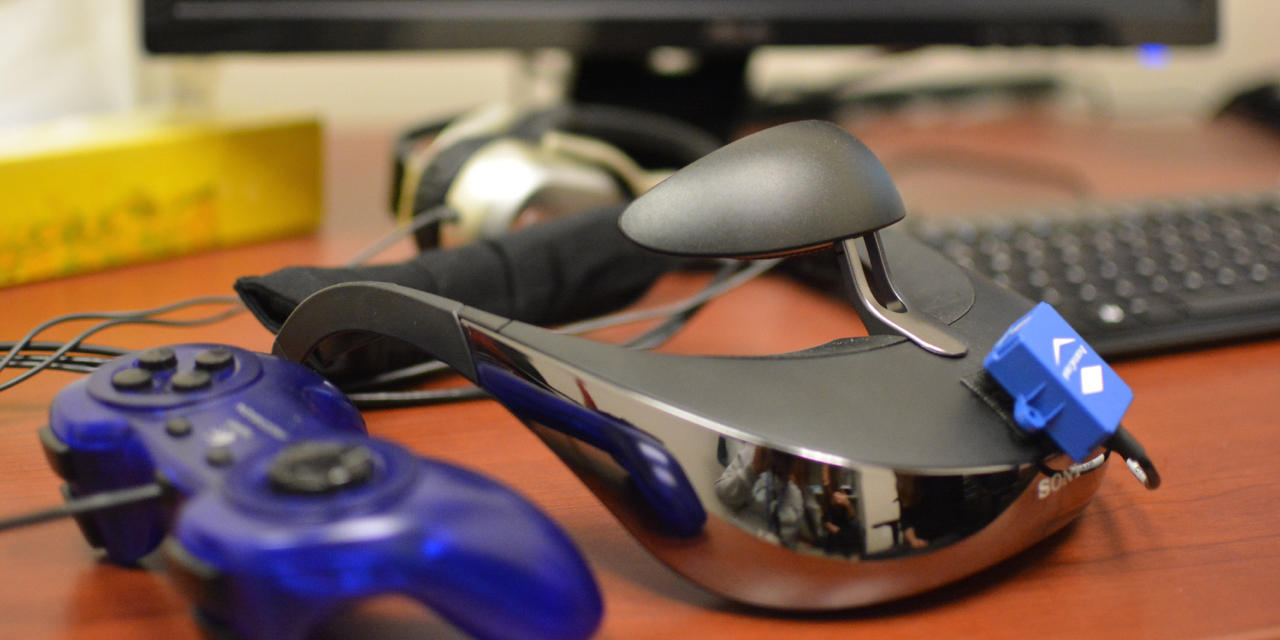Emory Uses Virtual Reality To Treat Military Sexual Trauma Survivors

Patients wear a virtual reality head-mounted display and use a controller to move around in the virtual world. An average headset now costs about $1,500. In 1995, it cost $14,000.
ALISON GUILLORY / WABE
Virtual reality is being used in a lot of new ways.
At Emory University, researchers are using virtual reality to treat veterans who suffered sexual abuse in the military and now have posttraumatic stress disorder (PTSD).
Inside a dark room, patients wear a head-mounted display, headphones, hold a joystick in their hands and sit on a chair where they can feel vibrations.
As they move their heads, they can see anything above them – like the sky, if they look down, they can see their feet.
Emory University psychiatry professor Barbara Rothbaum has been using virtual reality to treat anxiety disorders since 1995.
“The technology has definitely improved over the years, but we are not like a video game,” Rothbaum said.
Rothbaum said wearing a virtual reality headset to see and hear the sounds from a particular place can help patients confront what happened.
According to the U.S. Department of Veterans Affairs, one in four women and one in 100 men who seek out VA services say they have experienced sexual trauma in the military. Immediately or many years after the incident, veterans may suffer from PTSD related to it.
“A lot of military sexual trauma survivors have avoided relationships, crowds, going to the gym, so we figure if we can place them in that situation and have them go back to the time of the memory and recount it over and over, we’re hopeful that that can help them even more than regular therapy,” Rothbaum said.
Along with Georgia Tech, Rothbaum and Emory University hold the patent for using virtual reality to treat psychiatric disorders.
Engaging Memories
As awareness of sexual abuse in the military grows, Rothbaum said she is now focused on helping veteran sexual trauma survivors.
“We’re not presenting them with somebody who’s trying to attack them or a door that won’t open,” Rothbaum said. “We’re presenting them with cues that for someone who wasn’t assaulted would probably be neutral.”
The scenes can be altered based on the patient’s memory. The program allows the researcher to place a patient where the incident occurred – like inside military barracks in Iraq or inside a car in Afghanistan or a bar in the United States.
Rothbaum said the nature of PTSD is avoidance and denial. But just putting them in the place allows them to recall a memory and fill in the details.
“A lot of times people just think they’re not coping or they’re being a baby or they’re being a wimp and don’t realize, ‘No, I’ve got PTSD, it’s a diagnosis, and it’s got good treatments that work’,” Rothbaum said.
During the treatment, patients sometimes see things that are not on the headset screen in a custom program called Bravemind. During the hour-long sessions, researchers measure how much stress a patient feels through their salivary cortisol output and how their body is responding to different settings.
Since the study began this fall, two veterans who have PTSD from military sexual trauma have gone through the treatment.
The study, which is free for veterans, will conclude late next year, but Rothbaum said if it’s effective, she hopes to continue treating patients using the technology.








